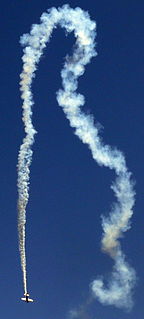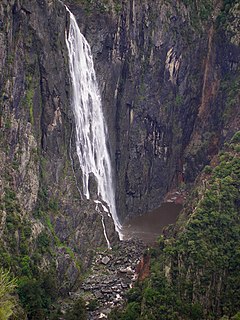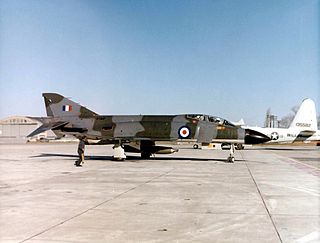
Aerobatics is the practice of flying maneuvers involving aircraft attitudes that are not used in normal flight. Aerobatics are performed in airplanes and gliders for training, recreation, entertainment, and sport. Additionally, some helicopters, such as the MBB Bo 105, are capable of limited aerobatic maneuvers. An example of a fully aerobatic helicopter, capable of performing loops and rolls, is the Westland Lynx.

The Wollomombi Falls is a plunge waterfall on the Wollomombi River in the New England region of New South Wales, Australia.

A floatplane is a type of seaplane, with one or more slender pontoons mounted under the fuselage to provide buoyancy. By contrast, a flying boat uses its fuselage for buoyancy. Either type of seaplane may also have landing gear suitable for land, making the vehicle an amphibious aircraft. British usage is to call "floatplanes" "seaplanes" rather than use the term "seaplane" to refer to both floatplanes and flying boats.

The Rolls-Royce Thrust Measuring Rig (TMR), was a pioneering vertical take-off and landing (VTOL) aircraft developed by Rolls-Royce in the 1950s. It has the distinction of being "the first jet-lift aircraft to fly anywhere in the world".

The Yakovlev Yak-18 was a tandem two-seat military primary trainer aircraft manufactured in the Soviet Union. Originally powered by one 119 kW (160 hp) Shvetsov M-11FR-1 radial piston engine, it entered service in 1946. It was also produced in China as the Nanchang CJ-5.
This glossary of wildfire terms is a list of definitions of terms and concepts relevant to wildfires and wildland firefighting. Except where noted, terms have largely been sourced from a 1998 Fireline Handbook transcribed for a Conflict 21 counter-terrorism studies website by the Air National Guard.
In aviation, atmospheric sciences and broadcasting, a height above ground level (AGL) is a height measured with respect to the underlying ground surface. This is as opposed to altitude/elevation above mean sea level (AMSL), or height above average terrain (HAAT). In other words, these expressions indicate where the "zero level" or "reference altitude" is located.

In aerodynamics, the flight envelope, service envelope, or performance envelope of an aircraft or interplanetary spacecraft refers to the capabilities of a design in terms of airspeed and load factor or atmospheric density, often simplified to altitude for Earth-borne aircraft. The term is somewhat loosely applied, and can also refer to other measurements such as manoeuvrability. When a plane is pushed, for instance by diving it at high speeds, it is said to be flown "outside the envelope", something considered rather dangerous.

A fire lookout tower, fire tower or lookout tower, provides housing and protection for a person known as a "fire lookout" whose duty it is to search for wildfires in the wilderness. The fire lookout tower is a small building, usually located on the summit of a mountain or other high vantage point, in order to maximize the viewing distance and range, known as view shed. From this vantage point the fire lookout can see smoke that may develop, determine the location by using a device known as an Osborne Fire Finder, and call fire suppression personnel to the fire. Lookouts also report weather changes and plot the location of lightning strikes during storms. The location of the strike is monitored for a period of days after in case of ignition.

S7 Airlines Flight 778(RU778/SBI778) was an Airbus A310-300 on a scheduled domestic passenger flight, serving the route from Moscow Domodedovo to Irkutsk, when it crashed upon landing at Irkutsk International Airport at 07:44 local time on 9 July 2006. The plane overshot the runway, sliding over several hundred metres of wet runway and grass. It crashed through a concrete barricade, hit a group of private garages and burst into flames. Television pictures showed smoking ruins of the Airbus with only the tail section intact. It took two hours for local firefighters from five different fire stations to extinguish the blaze.
Dundigal Air Force Academy is located 43 km from Hyderabad, in the Indian state of Telangana.

A drill tower is a tower and training facility for firefighters. It is usually built within a fire station facility for routine exercises and training.

Antenna farm or satellite dish farm or just dish farm are terms used to describe an area dedicated to television or radio telecommunications transmitting or receiving antenna equipment, such as C, Ku or Ka band satellite dish antennas, UHF/VHF/AM/FM transmitter towers or mobile cell towers. The history of the term "antenna farm" is uncertain, but it dates to at least the 1950s.

The Fairchild 91,, was a single-engine eight-passenger flying boat airliner developed in the United States in the mid-1930s.
BUMMMFITCHH is one form of a mnemonic used by pilots to remember the sequence of actions required when an aeroplane is on approach to land. A shorter version for simple aircraft is BMFFH; many variations exist for different aircraft types.

The Macchi M.5 was an Italian single-seat fighter flying boat designed and built by Nieuport-Macchi at Varese. It was extremely manoeuvrable and agile and matched the land-based aircraft it had to fight.

The 1974 Norfolk mid-air collision happened on 9 August 1974 at Fordham Fen, Norfolk, England when a Royal Air Force McDonnell-Douglas F-4M Phantom FGR.2 of No. 41 Squadron RAF collided with a Piper PA-25-235 Pawnee crop spraying aircraft. All three aviators were killed, the pilot and navigator of the Phantom and the pilot of the Pawnee. The Phantom pilot was a Royal Air Force Group Captain and station commander of RAF Coningsby. It was the first collision between a civil and military fast jet aircraft in the United Kingdom low flying military training system.

The Zeppelin-Lindau Rs.III was a large four-engined monoplane flying boat designed by Claudius Dornier and built during 1917 on the German side of Lake Constance at the Zeppelin-Lindau works.
The Sikorsky S-45 was a proposed double-deck transoceanic flying boat originally designed in 1938 by Sikorsky Aircraft for Pan Am. The high wing monoplane featured a single-step hull with a triple-tail and was to be powered by six Wright R-3350 Duplex-Cyclone engines which were being developed at the time. The aircraft would have competed with the Boeing 314 but no examples of the S-45 were ever manufactured.
















